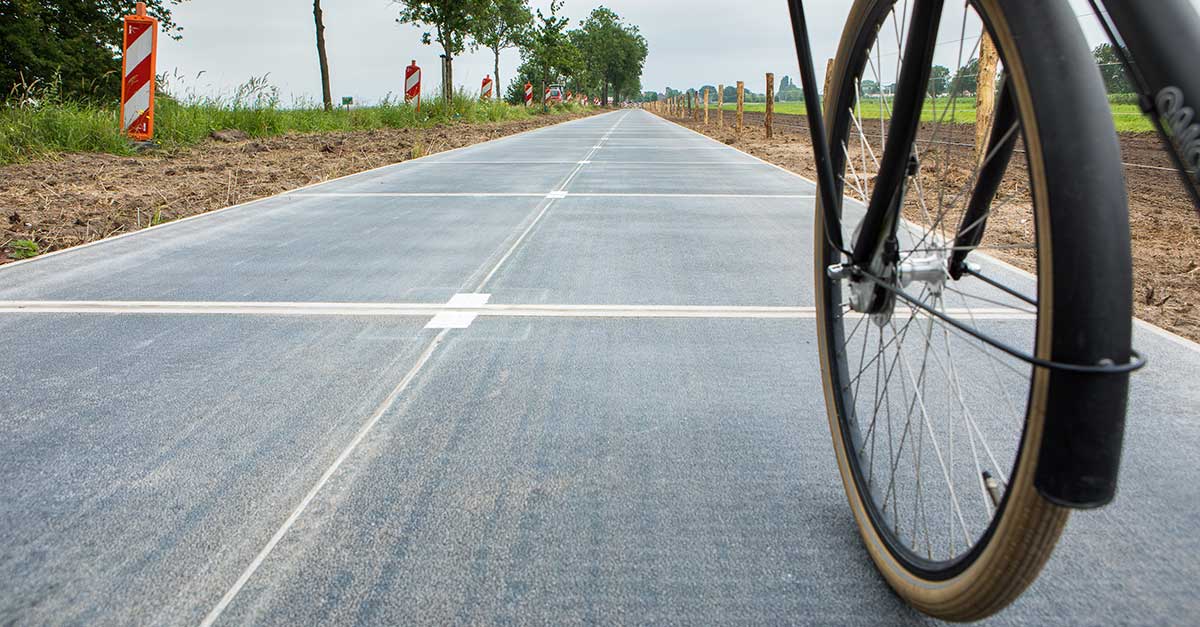
Solar panels embedded in the road surface have the potential to make a major contribution to greening electricity consumption, according to the Dutch research institute TNO. If the 140,000 kilometers of its roads are used as optimally as possible, this would account for about 10% of the Netherlands’ electricity consumption.
After a number of pilot projects with bicycle paths in the Netherlands and France, the SolaRoad consortium is about to make the move towards Germany and Belgium. The tests are going so well that the photovoltaic road surface is also beginning to become commercially interesting, says Ando Kuypers of TNO.
In addition to TNO, road construction company Strukton, installation company SPIE and the VLAQ group are also involved in SolaRoad. For the time being, it is primarily concerned with bicycle paths. At a later stage, highways will also be a possibility, but more tests will have to be done first for this, according to Kuypers. Previous tests have shown that the weight of cars in combination with frost, for example, can pose problems.
Concrete panels
In the construction of a bike path with solar cells, concrete elements are laid first. The solar panels – with a transparent wear and tear layer – are then installed on top. Kuypers: “This combination makes solar bike paths relatively expensive at present, also because the pilot projects are limited to a few hundred metres and involve manual work. When scaling up to longer bike paths, the electricity costs will indeed be higher than for a classic solar park, but they will probably be at an acceptable level for commercial use.”

Kuypers compares it to offshore wind turbines: “These were started because there was not much available space on land. The fact that offshore construction is more expensive was accepted. But now that it is being used on an increasingly larger scale, the cost differential with onshore wind turbines is becoming less and less.
Kuypers believes that an optimal use of public space will also play an ever greater role where bicycle paths and highways are concerned.
“In the Netherlands, but also within a EU context, road authorities and governments are steadily more interested in using infrastructure not only for mobility, but also to generate green electricity,” says SolaRoad’s director Arian de Bondt. This not only applies to roads, but also, for example, to noise barriers along motorways and railroads.
Pilot projects
The SolaRoad consortium has so far carried out trials with bicycle paths in the Dutch towns of Krommenie (2014), Blauwestad (2017), Haaksbergen (2018), Geldermalsen (2021) and three locations in France. The concept was also used in a bicycle path between Utrecht and Hilversum (see photo). With a length of more than 300 meters, this is the longest solar bike path in the world.
The next project in the Netherlands is on the Brightlands Chemelot Campus in Geleen. Work is also underway on projects in Belgium and Germany. These are taking place within the EU-supported Rolling Solar Interreg project aimed at further perfecting the technology and making solar roads profitable as soon as possible.
Partners in this project include Hasselt University, the Jülich Research Center, RWTH Aachen Technical University, the imec research organization, Zuyd University of Applied Sciences, HELMo University College and several companies.
35,000 kilometers of bicycle path
Thanks to the technological advances that SolaRoad has made, the bike paths now generate about 120 kilowatt hours of renewable electricity per square meter on an annual basis, says De Bondt. The Netherlands has an estimated 35,000 kilometers of bike paths. “If we equipped all of those with solar cells, we could generate about 15 terawatt hours of electricity per year and avoid five million tonnes of CO2 emissions.”
This is interesting for road authorities, for example, to power street lighting. And with the increasing number of electric bikes, installing charging points is also an obvious move. “This is an attractive option in the Rolling Solar project for our two neighboring countries as well,” De Bondt points out. Naturally, the electricity can also be added to the national power grid.
Noise barriers
As already mentioned, TNO is not only working on photovoltaic roads, but also on anti-noise walls and crash barriers. According to Kuypers, tests are now being conducted with the company Solliance on so-called tandem solar cells that consist of a combination of perovskite with, as an example, a CIGS cell. The hope is that, in time, these will be able to replace traditional silicon solar cells.
Also interesting: Solliance is testing 72 meters of flexible solar cells in crash barrier

